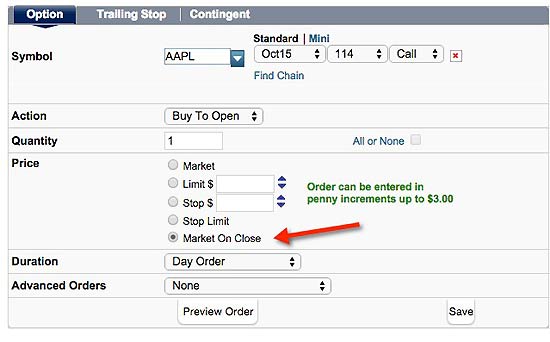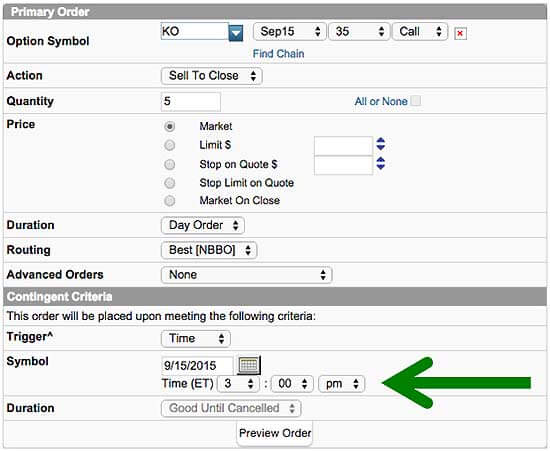The cost of emotional investing can be severe. Traders stay in trades longer when they're sure a company they have an emotional attachment to will turn things around, even when all evidence is to the contrary.
We simply don't make good decisions when our emotions are running high, and the ups and downs of the market are more than enough to put you in a state where you're not making good decisions with your money. And the last thing you want to do is subject your money to the whims of your emotions.
That's not investing - that's gambling.
Last week, I told you that orders are one of the best ways to remove your emotions from your options trades.
Today, I'll show you a few more orders to help you maximize your returns and protect your investing capital...
Contingent Orders
 This too is an order type that allows for you to be elsewhere in your life tending to other things while still having some management control over your open options positions.
This too is an order type that allows for you to be elsewhere in your life tending to other things while still having some management control over your open options positions.
The basic premise with using a contingent order on an open options position is that you want to sell-to-close your options when a stock hits a specific price.
Let's say you own an October $40 Call option because Money Calendar showed you a historical accuracy of making an average six-point profit nine out of the last 10 years.
Let's say the price of the stock when you opened the options trade on it was $43.50. Add to that price the six points Money Calendar calls for, and the target price on the stock would be $49.50.
If you have an options risk graph, you can use that to anticipate the theoretical value of the option at that stock price. If you do not have the luxury of an options risk graph, then you can at least place an order to sell that option "contingent" upon that stock hitting $49.50.
You may not know exactly what the option price would be, but you know that is what you want/need based off the Money Calendar analysis.
You would place the order in your automated trading platform as an advanced order type, specifically a contingent order. You would set the contingent order price to trigger on the "last" - or the latest trade so far today - at "greater than or equal to" $49.50.
When the latest or last trade so far in the day (not the last trade of the day at market close) hits $49.50 or higher, the order to sell the October $40 Call will be executed. It will be executed as a market order because not even computers will know what the price will be ahead of time.
You can place a contingent order as a stop order as well. If you have a support price in mind for the stock, say $41.50, you can place a contingent order to close the trade contingent on the stock trading down to $41.50. It will trigger on the last price "less than or equal to" $41.50.
You can also place a contingent order based on time.
For example, if you know of a pending news event - like the Fed's recent decision on whether or not to raise interest rates - and you know this type of event can cause wild swings in the market, you can use a contingent order to sell when the clock strikes a specific time.
The Fed's announcement was due at 2 p.m. Eastern, so you could have placed your order to close your trades contingent on it being 1:45 p.m. Eastern. Again, this is a market order, but it ensures you are out of the trades before the big event that could impact the markets.
Market-on-Close (MOC) Orders
A market-on-close order, or MOC order, is a market order (non-limit) that will be filled as close to the market close as possible. You must have your order in place by at least 3:45 p.m. Eastern for the NYSE and 3:50 p.m. for the Nasdaq (note that neither of the exchanges allow for you to modify or cancel the order after those times).
The reason you'd consider a market-on-close order is not only because you are going to be away from your screens, but also because you want to be able to participate in a stock move, trading the options on it, prior to an expected event occurring after the market close.
That includes economic reports like new housing starts, the jobs report, or an earnings announcement. All could have a dramatic impact on a stock - and its options.
One note about MOC orders. The fact is, they are basically a market order - and some traders are not inclined to use them as they may cost a couple of ticks one way or the other, and they would rather stick with their limit orders to get the best price.
But you can use them to modify your limit orders. For example, if you don't hit your limit during the trading day and are worried about an after-hours event impacting your trade, you can also add an MOC order to get out before the news hits.
Good-til-Canceled (GTC) Orders
[mmpazkzone name="in-story" network="9794" site="307044" id="137008" type="4"]
When you place an order, you can place it as a "day order" or a good-til-canceled order, also called a GTC order.
A day order is just that, an order that is good for the trading day only. If at the end of the trading day your order remains unfilled, it will be automatically canceled.
The GTC order will remain in place until either you cancel it or the fill price gets met. If you do not place a GTC order, most likely the trade will be set as a day order, and you have to place another order the next day if it is not filled.
Confer with your brokerage as to how long their GTC orders stay in place. They could be anywhere between 30 and 90 days, but I see the average as 60 days.
Your Options Trading Lesson Summary
Specific, sophisticated orders are absolutely critical to your success as an options trader. To summarize:
- Contingent orders let you sell your options position based on the price of the underlying stock.
- Market-on-close orders let you avoid after-hours events impacting your trades.
- Good-til-canceled orders allow your orders to stay in the market until they're filled.
Follow us on Twitter @moneymorning.
Taking Emotion Out of the Equation: Emotions run high when the markets move fast, as they often do. But you don't have to make difficult, spur-of-the-moment decisions about your money in high-pressure situations. Tailoring your orders to fit your trades helps remove emotion from the investing equation, ultimately protecting your money...
About the Author
Tom Gentile, options trading specialist for Money Map Press, is widely known as America's No. 1 Pattern Trader thanks to his nearly 30 years of experience spotting lucrative patterns in options trading. Tom has taught over 300,000 traders his option trading secrets in a variety of settings, including seminars and workshops. He's also a bestselling author of eight books and training courses.




